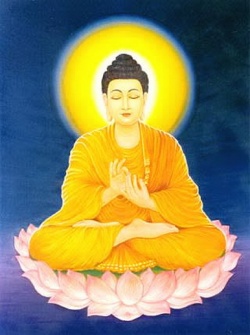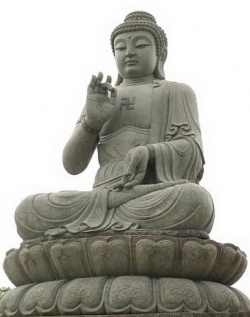Samatha
- See also :
- See also :
Samatha (Pāli), (Sanskrit: शमथ, śamatha; also romanized to shamatha, Tib. ཞི་གནས་, shyiné; Wylie: zhi gnas; English: "calm" or "tranquility") refers to that dimension of Buddhist spiritual cultivation (Bhavana) concerned with the calming of the mind (Citta) and its 'formations' (Sankhara).
When calm the mind is capable of concentration (Samadhi) and is put into a suitable frame for the arising of insight (vipassana) and thus Wisdom (Pañña).
In Buddhism, calmness and concentration of mind are considered to be dependent on the presence of morality (Śīla) in a person's Life.
With morality as the foundation, calming of the mind (samatha) and the arising of insight (vipassana) are summed up as the quintessence of Buddhist spiritual cultivation (Bhavana).
In Sri Lanka samatha includes all the meditations directed at static objects. In Burma, samatha comprises all concentration practices, aimed at calming the mind.
The Thai Forest tradition deriving from Ajahn Mun and popularized by Ajahn Chah stresses the inseparability of samatha and vipassana.
Samatha is commonly used in Theravada Buddhism, Tibetan Buddhism and various branches of the Pure land tradition.
Etymology
The Tibetan term for samatha is shyiné (Wylie: zhi-gnas). According to Jamgon Kongtrul, insight may be garnered by an exegesis of the etymology of śamatha and shyiné:
- The Tibetan term is shyiné; shi-ne (shi-gnas) and the Sanskrit is Shamatha. In the case of the Tibetan, the first syllable, shi, and in the case of the Sanskrit, the first two syllables, shama, refer to "peace" and "pacification".
The meaning of peace or pacification in this context is that normally our mind is like a whirlwind of agitation. The agitation is the agitation of thought.
Our thoughts are principally an obsessive concern with past, conceptualization about the present, and especially an obsessive concern with the future.
This means that usually our mind is not experiencing the present moment at all.
The semantic field of shi and shama is "pacification", "the slowing or cooling down", "rest". The semantic field of né is "to abide or remain" and this is cognate or equivalent with the final syllable of the Sanskrit, thā.
Overview
In the Pali canon, the Buddhist path of practice is simplified into three divisions, namely Morality (sila), Concentration (Samadhi) and Wisdom (Pañña). Each division is dependent on the former.
For example, Wisdom (constituted by the arising of insight) is dependent on the mind's ability to be still and concentrate.
However, for the mind to be unruffled, a firm basis of morality must be present in the person's Life. Morality is the foundation of all Buddhist spiritual cultivation and of samatha (calm) in particular.
When the mind is calm, concentration not only becomes possible but tends to naturally arise in some form.
What is generically referred to as 'Buddhist meditation' by non-Buddhists is the calming and concentration of the mind in seated pose.
Application
Samatha (calm) is considered to be a prerequisite of concentration.
In terms of meditative practices samatha refers to techniques which assist in the calming of the mind.
One of the principal techniques taught by The Buddha for this purpose is Mindfulness of breathing (Pali: anapanasati).
This practise is also used in order to concentrate the mind. As such, samatha meditation and concentration meditation are often considered synonymous.
The goal is the establishing of Mindfulness as used in conjunction with insight (P: vipassanā; S: vipaśyanā) practices,
inquiry into the nature of the object, such as those encountered in the Dzogchen tradition, resulting in Wisdom (P: paññā, S: prajñā). Samatha is commonly practiced as a prelude to and in conjunction with Wisdom practices.
Through the meditative development of calm abiding, one is able to suppress the obscuring five hindrances. With the suppression of these hindrances, the meditative development of insight yields liberating Wisdom.
In the Theravada tradition there are forty objects of meditation. Mindfulness (sati) of breathing (ānāpāna: ānāpānasati; S. ānāpānasmṛti) is the most common samatha practice. Samatha can include other Samādhi practices as well.
Some meditation practices such as contemplation of a Kasina object favor the development of samatha, others such as contemplation of the aggregates are conducive to the development of vipassana, while others such as Mindfulness of breathing are classically used for developing both mental qualities.
Origins
The Buddha is said to have identified two paramount mental qualities that arise from wholesome meditative practice:
- Samatha, calm abiding, which steadies, composes, unifies and concentrates the mind;
- Vipassanā, insight, which enables one to see, explore and discern "formations" (conditioned phenomena based on the five aggregates).
The Buddha is said to have extolled serenity and insight as conduits for attaining the unconditioned state of Nibbana (Pāli; Skt.: Nirvana).
For example, in the Kimsuka Tree Sutta (SN 35.245), The Buddha provides an elaborate metaphor in which serenity and insight are "the swift pair of messengers" who deliver the message of Nibbana via the Noble Eightfold Path.
In the Four Ways to Arahantship Sutta (AN 4.170), Ven. Ānanda reports that people attain arahantship using calm abiding and insight in one of three ways:
- They develop calm abiding and then insight (Pāli: samatha-pubbangamam vipassanam
- They develop insight and then calm abiding (Pāli: vipassana-pubbangamam samatham)
- They develop calm abiding and insight in tandem (Pāli: samatha-vipassanam yuganaddham), for instance, obtaining the first Jhāna and then seeing in the associated aggregates the three marks of existence before proceeding to the second Jhāna.
In the Pāli Canon, The Buddha never mentions independent samatha and vipassana meditation practices; instead, samatha and vipassana are two "qualities of mind" to be developed through meditation. As Thanissaro Bhikkhu writes,
- When [the Pāli suttas depict The Buddha telling his disciples to go meditate, they never quote him as saying 'go do vipassana,' but always 'go do Jhana.' And they never equate the word "vipassana" with any Mindfulness techniques.
In the few instances where they do mention vipassana, they almost always pair it with samatha — not as two alternative methods, but as two qualities of mind that a person may 'gain' or 'be endowed with,' and that should be developed together.
Similarly, referencing MN 151, vv. 13-19, and AN IV, 125-27, Ajahn Brahm (who, like Bhikkhu Thanissaro, is of the Thai Forest Tradition) writes that
- Some traditions speak of two types of meditation, insight meditation (vipassana) and calm meditation (samatha). In fact the two are indivisible facets of the same process. Calm is the peaceful Happiness born of meditation; insight is the clear understanding born of the same meditation. Calm leads to insight and insight leads to calm."
Contemporary Theravāda interpretations
In the last decade samatha in the Burmese tradition has been popularized in the west by Pa Auk Sayadaw. This tradition upholds the emphasis on samatha explicit in the commentarial tradition of the Visuddhimagga.
Pa Auk Sayadaw presented this tradition through extensive retreats around the world until his retirement in 2012. In 2005, Tina Rasmussen and Stephen Snyder completed the entire detailed samatha path under Pa Auk Sayadaw's direct supervision.
They were subsequently the first Western lay people whom he authorized to teach. Snyder and Rasmussen, in their retreats and in their book, Practicing The Jhanas: Traditional Concentration Meditation As Presented By The Venerable Pa Auk Sayadaw, present these rigorous traditional teachings in a context accessible to western lay-practitioners.
The Thai Forest tradition deriving from Ajahn Mun and popularized by Ajahn Chah stresses the inseparability of samatha and vipassana, and the essential necessity of both practices.
A 2008 book by Richard Shankman entitled The Experience of Samadhi: An In-depth Exploration of Buddhist Meditation comparatively surveys the treatment of samatha in the suttas, in the commentarial tradition of the Visuddhimagga, and among a number of prominent contemporary Theravāda teachers of various orientations.
Indo-Tibetan tradition
Mahayana sūtras
A number of Mahāyāna sūtras address śamatha, usually in conjunction with vipaśyanā.
One of the most prominent, the Cloud of Jewels Sutra (Ārya Ratnamegha Sutra, Tib. 'phags-pa dkon-mchog sprin-gyi mdo) divides all forms of meditation into either śamatha or vipaśyanā, defining śamatha as "single-pointed consciousness" and vipaśyanā as "seeing into the nature of things."
The Sūtra Unlocking the Mysteries (Samdhinirmocana Sūtra), a yogācāra Sūtra, is also often used as a source for teachings on śamatha. The Samādhirāja Sūtra is often cited as an important source for śamatha instructions by the Kagyu tradition,
particularly via commentary by Gampopa, although scholar Andrew Skilton, who has studied the Samādhirāja Sūtra extensively, reports that the Sūtra itself "contains no significant exposition of either meditational practices or states of mind."
Dhyana
Samatha furthers the Right concentration aspect of the Noble Eightfold Path. The successful result of samatha is also sometimes characterized as meditative absorption (Samādhi, ting nge ’dzin) and meditative equipoise (samāhita, mnyam-bzhag), and freedom from the five obstructions (āvaraṇa, sgrib-pa). It may also result in the Siddhis of clairvoyance (abhijñā, mgon shes) and magical emanation (nirmāna, sprul pa).
Factors in śamatha
Nine mental abidings
In a formulation originating with Asaṅga (4th CE), śamatha practice is said to progress through nine "mental abidings" or Nine stages of training the mind (S. navākārā cittasthiti, Tib. sems gnas dgu), leading to śamatha proper (the equivalent of "access concentration" in the Theravāda system), and from there to a state of meditative concentration called the first Dhyāna (Pāli:
Jhāna; Tib. bsam gtan) which is often said to be a state of tranquillity or bliss.
Asaṅga delineates the nine mental abidings in his Abhidharmasamuccaya and the Śrāvakabhūmi chapter of his Yogācārabhūmi-śāstra. It is also found in the Mahāyānasūtrālaṅkāra of Maitreyanātha.
The Nine Mental Abidings (navākārā cittasthiti, sems-gnas dgu) are:
- 1. Placement of the mind (S. cittasthāpana, Tib. འཇོག་པ - sems ’jog-pa) occurs when the practitioner is able to place his attention on the object of meditation, but is unable to maintain that attention for very long. Distractions, dullness of mind and other hindrances are common.
- 2. Continuous attention (S. samsthāpana, Tib. རྒྱུན་དུ་འཇོག་པ - rgyun-du ‘jog-pa) occurs when the practitioner experiences moments of continuous attention on the object before becoming distracted. According to B Alan Wallace, this is when you can maintain your attention on the meditation object for about a minute.
- 3. Repeated attention (S. avasthāpana, Tib. བླན་ཏེ་འཇོག་པ - slan-te ’jog-pa) is when the practitioner's attention is fixed on the object for most of the practice session and he is able to immediately realize when he has lost his mental hold on the object and is able to restore that attention quickly. Sakyong Mipham Rinpoche suggests that being able to maintain attention for 108 breaths is a good benchmark for when we have reached this stage.
- 4. Close attention(S. upasthāpana, Tib. ཉེ་བར་འཇོག་པ - nye-bar ’jog-pa) occurs when the practitioner is able to maintain his attention throughout the entire meditation session (an hour or more) without losing their mental hold on the meditation object at all. In this stage the practitioner achieves the Power of Mindfulness. Nevertheless, this stage still contains subtle forms of excitation and dullness or laxity.
- 5. Tamed attention (S. damana", Tib. དུལ་བར་བྱེད་པ - "dul-bar byed-pa), by this stage the practitioner achieves deep tranquility of mind, but must be watchful for subtle forms of laxity or dullness, peaceful states of mind which can be confused for calm abiding. By focusing on the future benefits of gaining Shamatha, the practitioner can uplift (gzengs-bstod) his mind and become more focused and clear.
- 6. Pacified attention (S. śamana,Tib. ཞི་བར་བྱེད་པ་ - zhi-bar byed-pa) is the stage during which subtle mental dullness or laxity is no longer a great difficulty, but now the practitioner is prone to subtle excitements which arise at the periphery of meditative attention. According to B. Alan Wallace this stage is achieved after only after thousands of hours of rigorous training.
- 7. Fully pacified attention (S. vyupaśamana,Tib. རྣམ་པར་ཞི་བར་བྱེད་པ་ - nye-bar zhi-bar byed-pa), although the practitioner may still experience of subtle excitement or dullness, they are rare and he can easily recognize and pacify them.
- 8. Single-pointed attention (S. ekotīkarana, Tib. རྩེ་གཅིག་ཏུ་བྱེད་པ་ - rtse-gcig-tu byed-pa) in this stage the practitioner can reach high levels of concentration with only a slight effort and without being interrupted even by subtle laxity or excitement during the entire meditation session.
- 9. Attentional Balance (S. samādhāna,Tib. མཉམ་པར་འཇོག་པ་བྱེད་པ་ - mnyam-par ’jog-pa) the meditator now effortlessly reaches absorbed concentration (ting-nge-‘dzin, S. Samadhi.) and can maintain it for about four hours without any single interruption.
Five faults and eight antidotes
The system of the five faults and eight antidotes originates with Maitreyanātha's Madhyānta-vibhāga. The whole system is elaborated further in the three Bhāvanā krama texts (particularly the second one) of Kamalaśīla, a later author, and by generations of Tibetan commentators. Thus the following shamatha formulation derives originally from the Yogācāra tradition.
Five faults
To practice śamatha, one must select an object of observation (ālambana, dmigs-pa). Then one must overcome the five faults (ādīnava, nyes-dmigs):
Eight antidotes
Using the eight antidodes (pratipakṣa, gnyen-po) or applications (abhisamskāra, ’du-byed pa):
- for Laziness:
- 1. Faith (śraddhā, dad-pa)
- 2. aspiration (Chanda, ’dun-pa)
- 3. exertion (vyayama, rtsol-ba)
- 4. pliancy (Praśrabdhi, shin-sbyangs)
- for forgetting the instruction:
- 5. mindfulness (smṛti, dran-pa)
- for laxity and excitement
- 6. awareness (samprajaña, shes-bzhin)
- for non-application
- 7. application (abhisaṃskāra, ’du byed-pa)
- for overapplication
Six Powers
Six powers (bala, stobs) are also needed for śamatha:
- 1. hearing (śruta, thos-pa)
- 2. thinking (cintā, bsam-pa)
- 3. Mindfulness (smṛti, dran-pa)
- 4. awareness (samprajaña, shes-bzhin)
- 5. effort (Vīrya, brtson-’grus)
- 6. familiarity (paricaya, yong-su ’dris-pa)
Four modes of mental enagagement
Four modes of mental enagagement (manaskāra, yid-la byed-pa) are said to be possible:
Mahāmudrā and Dzogchen
Śamatha is approached somewhat differently in the mahāmudrā tradition as practiced in the Kagyu lineage. As Traleg Kyabgon Rinpoche explains,
- In the practice of Mahamudra tranquility meditation ... we treat all thoughts as the same in order to gain sufficient distance and detachment from our current mental state, which will allow us to ease naturally into a state of tranquility without effort or contrivance [...]
In order for the mind to settle, we need to suspend the value judgments that we impose on our mental activities [...] it is essential that we not try to create a state of tranquility but allow the mind to enter into tranquility naturally.
This is an important notion in the Mahamudra tradition, that of nondoing. We do not do tranquility mediation, we allow tranquility to arise of its own accord, and it will do so only if we stop thinking of the meditative state as a thing that we need to do actively [...] In a manner of speaking, catching yourself in the act of distraction is the true test of tranquility meditation, for what counts is not the ability to prevent thoughts or emotions from arising but the ability to catch ourselves in a particular mental or emotional state.
This is the very essence of tranquility meditation [in the context of Mahāmudrā [...] The Mahamudra style of meditation does not encourage us toward the different levels of meditative concentration traditionally described in the exoteric mediation manuals [...] From the Mahamudra point of view, we should not desire meditative equipoise nor have an aversion to discursive thoughts and conflicting emotions but view both of these states with Equanimity.
Again, the significant point is not whether meditative equipoise is present but whether we are able to maintain awareness of our mental states. If disturbing thoughts do arise, as they certainly will, we should simply recognize these thoughts and emotions as transient phenomena.
For the Kagyupa, in the context of mahāmudrā, śamatha by means of Mindfulness of breathing is thought to be the ideal way for the meditator to transition into taking the mind itself as the object of meditation and generating vipaśyanā on that basis.
Quite similar is the approach to śamatha found in Dzogchen semde (Sanskrit: mahāsandhi cittavarga).
In the semde system, śamatha is the first of the four yogas (Tib. naljor, Wylie: rnal-’byor), the others being vipaśyanā (Wylie: lhag-mthong), nonduality (advaya, Tib. nyime , Wylie: gnyis-med),
and spontaneous presence (anābogha or nirābogha, Tib. lhundrub, Wylie: lhun-grub). These parallel the four yogas of mahāmudrā.
In June of 1996 Ajahn Amaro established Abhayagiri Monastery in Redwood Valley, California, where he was co-abbot with Ajahn Pasanno until July, 2010 Ajahn Amaro returned to Amaravati in July, 2010 and as a longtime student in the Thai Forest Theravādin tradition of Ajahn Chah, has also trained in the Dzogchen semde śamatha approach under Tsoknyi Rinpoche. He found similarities in the approaches of the two traditions to śamatha.
Relationship with vipaśyanā
Dzogchen [Pönlop Rinpoche)] clearly charts the developmental relationship of the practices of śamatha and vipaśyanā:
- The ways these two aspects of meditation are practised is that one begins with the practice of shamatha; on the basis of that, it becomes possible to practice vipashyana or lhagthong. Through one's practice of vipashyana being based on and carried on in the midst of shamatha, one eventually ends up practicing a unification yuganaddha of shamatha and vipashyana. The unification leads to a very clear and direct experience of the nature of all things. This brings one very close to what is called the absolute truth.
Similar practices in other religions
Meditations from other religious traditions may also be recognized as samatha meditation, that differ in the focus of concentration. In this sense, samatha is not a strictly Buddhist meditation.
Samatha in its single-pointed focus and concentration of mind is cognate with the sixth limb of aṣṭanga yoga', rāja yoga which is concentration (dhāraṇā). For further discussion, see the Yoga Sūtras of Patañjali.






